Aztec Warfare › Inca Art » Ancient origins
Articles and Definitions › Contents
- Aztec Warfare › Ancient History
- Inca Art › Antique Origins
Ancient civilizations › Historical and archaeological sites
Aztec Warfare › Ancient History
Definition and Origins
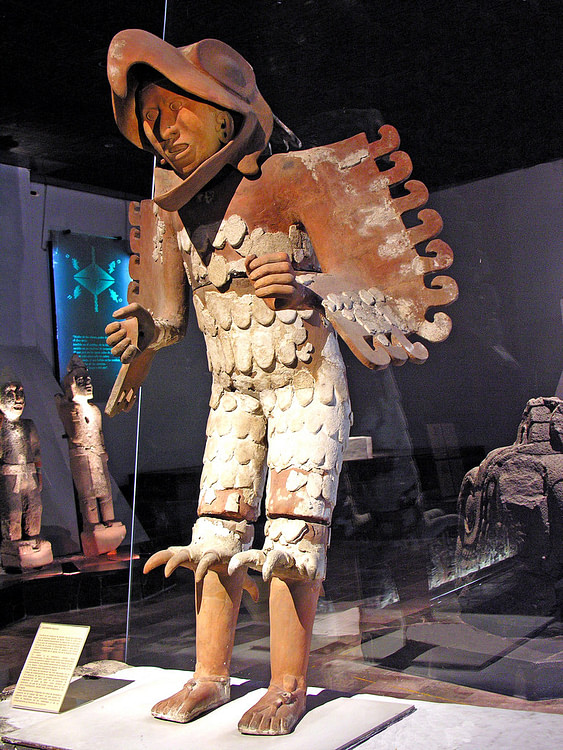
The Aztecs engaged in warfare ( yaoyotl ) to acquire territory, resources, quash rebellions, and to collect sacrificial victims to honour their gods. Warfare was a fundamental part of Aztec culture with all males expected to actively participate and battle, referred to in Nahuatl poetry as 'the song of shields', was regarded as a perpetual religious and political necessity. The Aztecs were so accomplished in combat that they eventually forged an empire which covered 200,000 square kilometres and, at the height of their power, they extracted tribute from 371 city -states across 38 provinces.
WARFARE IN AZTEC MYTHOLOGY
The Aztecs believed that the god of the sun and war Huitzilopochtli had been fully armed and ready for war from the very moment of his birth from his mother Coatlicue. Indeed, the first act of this blood-thirsty war god was to kill without mercy his rebellious sister Coyolxauhqui and his 400 siblings, the Centzonhuitznahuac and Centzonmimizcoa. In mythology, the dismembered bodies of Coyolxauhqui and the 400 became the moon and stars respectively. That warfare was an everyday reality is reflected in the Aztec belief that the conflict between Huitzilopochtli and his siblings re-occurred every day, symbolised by the contest between sun and moon each 24 hours. Further, that war was glorified is evidenced in the belief that fallen warriors accompanied the sun on his daily journey and later returned to earth as hummingbirds. Human sacrifices were regularly made to Huitzilopochtli at his temple atop the great pyramid, the Templo Mayor, at the Aztec capital Tenochtitlan. One of the most important such sacrificial ceremonies was held on the winter solstice, the traditional beginning of the campaign season.
ELITE UNITS COULD ONLY BE JOINED BY WARRIORS WHO HAD DISPLAYED NO FEWER THAN 20 ACTS OF BRAVERY IN BATTLE.
THE AZTEC ARMY
The military commander-in-chief was the king himself, the tlatoani. He was assisted by his second-in-command, who had the title cihuacoatl. Joining these two in a war council were four more of the highest ranking nobles, typically relatives of the king.These four had the titles of tlacochcalcatl, t laccetacatl, tillancalqui, and etzhuanhuanco. Reporting to the council were diverse units of warriors with varying levels of status, although it is important to note that brave and able soldiers could certainly climb through the ranks if they took a specific number of captives. Aztec symbols of rank included the right to wear certain feather headdresses, cloaks, and jewellery - lip, nose, and ear-plugs. Officers also wore large ensigns of reeds and feathers which towered above their shoulders. The most prestigious units were the cuauhchique or 'shaved ones' and the otontin or 'otomies'. These two elite units could only be joined by warriors who had displayed no fewer than 20 acts of bravery in battle and were already members of the prestigious jaguar and eagle warrior groups. Even the lowest ranks could win through valour privileges, such as the right to eat in the royal palaces, have concubines, and drink pulque beer in public.
Warriors were trained from a young age in special military compounds where children learnt to master weapons and tactics and where they were regaled with tales of battle from veteran warriors. Youths also accompanied the Aztec army on campaign, acting as baggage handlers, and when they finally became warriors and took their first captive, they could at last cut off the piochtli hair lock at the back of their necks which they had worn since the age of ten. Boys were now men and ready to fulfil their purpose: to die gloriously in battle and return as hummingbirds.
There is nothing like death in war,nothing like the flowery deathso precious to Him who gives life:far off I see it: my heart yearns for it!Nahuatl song
The Aztecs did not have a permanent or standing army but called up warriors when required. Each town was required to provide a complement of 400 men for campaigns, during which they would remain as a unit led by one of their own senior warriors and march under their own standard but also be a part of a larger group of 8,000 men. As many as 25 such divisions, or 200,000 men, could be mobilized for a large-scale campaign. Besides men, towns also had to provide supplies such as maize, beans, and salt, which would be carried on campaign by the baggage handlers. On the march the army was preceded by scouts, easily recognised by their yellow face-paint and conch-shell trumpets, and priests, who bore images of Huitzilopochtli. The main body of the army, often stretching some 25 kilometres along narrow trails, had the elite units leading from the front. Next came ordinary units from each of the empire's allies, starting with the armies of Tenochtitlan, and finally, the troops acquired from tribute quotas brought up the rear. When necessary, camps were simple affairs with reed mat shelters for the elite and the open-air for ordinary troops.
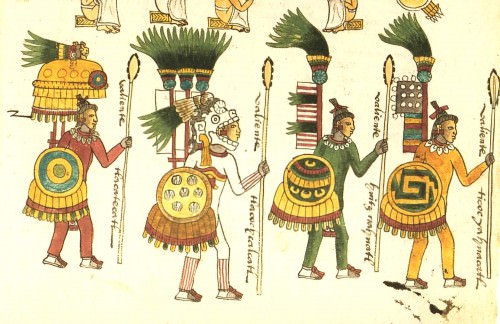
Aztec Warriors
WEAPONS & ARMOUR
Aztec warriors, who were taught from childhood in weapons handling, were expert users of clubs, bows, spears, and darts.Protection from the enemy was provided via round shields ( chimalli ) and, more rarely, helmets. Clubs or swords ( macuahuitl) were studded with fragile but super-sharp obsidian blades. Spears were short and used for jabbing and stabbing the enemy at close quarters. The atlatl was a dart-throwing device made of wood, and using one, an experienced warrior could direct accurate and deadly darts ( mitl ) or javelins ( tlacochtli ) while remaining a safe distance from the enemy or during the first stage of battle when the two armies lined up facing each other. Shields of wood or reeds were made more resistant with leather additions and decorated with heraldic designs such as birds, geometric shapes, and butterflies. Elite warriors could wear leather helmets, elaborately carved with symbols of their rank and unit. Body armour ( ichcahuipilli ) was also worn and made from quilted cotton which was soaked in salt water to make the garment stiffer and more resistant to enemy blows.There was no uniform as such, but ordinary warriors wore a simple tunic over a loincloth and wore war-paints. Elite warriors were much more impressively decked out with exotic feathers and animal skins. The Jaguar warriors wore jaguar skins and helmets with fangs, whilst the eagle warriors were dressed for battle in feathered suits complete with talons and a beaked helmet.
STRATEGIES
Usually campaigns began in order to redress a wrong such as the murder of traders, the refusal to give tribute, or failure to send representatives to important ceremonies at Tenochtitlan. The Aztecs also sought to create a buffer zone between their empire and neighbouring states. These areas were treated slightly better, allowed greater autonomy and were obliged to give less tribute. Yet another reason for war was the Coronation Wars. These were traditional campaigns whereby a new Aztec tlatoani proved his worth following his accession by conquering regions and acquiring tribute and prisoners for sacrifice.
Actual fighting was usually preceded by diplomatic missions where ambassadors ( quauhquauhnochtzin ) reminded of the price of defeat in battle and attempted to persuade a peaceful alternative of reasonable tribute and acceptance of the supremacy of the Aztec gods. Additionally, spies ( quimichtin or 'mice') could be sent into the target area disguised as merchants and dressed in local costume. If, upon the failure of diplomacy, war was still necessary and the defending army was defeated, then the principal city was sacked and the whole region considered conquered.
The battlefield is the place:where one toasts the divine liquor in war,where are stained red the divine eagles,where the jaguars howl,where all kinds of precious stones rain from ornaments,where wave headdresses rich with fine plumes,where princes are smashed to bits.Nahuatl song.
On the battlefield, usually a plain, combat was typically preceded by both armies facing each other with much shouting, posturing, and the beating of drums and blowing of conch-shell trumpets and bone flutes. Leaders positioned troops to best take advantage of local geographical features, and they led from the front and very much by example, throwing themselves into the battle. As the two armies faced off, heavy stones were thrown and followed by a more deadly volley of darts. Then came a bloody hand-to-hand combat, where the obsidian-bladed spears and clubs slashed the enemy creating fearsome wounds. Here all order was lost and battle became a series of independent duels where warriors tried to capture their opponent alive. Indeed, assistants with ropes followed the fighting in order to immediately truss up the vanquished for later sacrifice. Ruse tactics could also be employed, such as pretending to flee the battlefield or hiding in covered trenches in order to ambush enemy troops. Victory conventionally came when the enemy's main temple had been sacked. The discipline and sheer ferocity of the Aztec warriors was usually far superior to that of the enemy and ensured success after success across ancient Mexico.
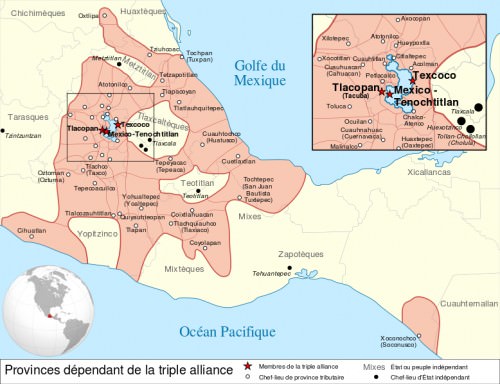
Aztec Empire
THE FLOWERY WARS
Besides the desire for new territory and war-booty, the Aztecs very often specifically went on campaign in order to acquire sacrificial victims. Indeed, both sides agreed to the battle beforehand, agreeing that the losers would provide warriors for sacrifice. The Aztecs believed that the blood of sacrificial victims, especially of brave warriors, fed the god Huitzilopochtli.Taken as captives after battles, the victims had their hearts removed and the corpse was skinned, dismembered and decapitated. These campaigns were known as xochiyaoyotl or a 'flowery war' because the victims were defeated warriors who were trussed up, and with their splendid feather war costumes, looked like flowers as they were unceremoniously transported back to Tenochtitlan. One Aztec general, named Tlacaelel, likened this process to shopping in a market and stated that the victims should be as easy to pick up as tortillas. A favourite hunting ground for these military expeditions was the eastern Tlaxcala state and cities such as Atlixco, Huexotzingo and Cholula. The earliest known example of a xochiyaoyotl was in 1376 CE against the Chalca, a conflict which, perhaps unsurprisingly, developed into a full-scale war. Generally speaking, though, the intention was only to take a sufficient number of victims and not to start all-out hostilities; for this reason many Aztec campaigns were not decisive engagements aimed at territorial control. Nevertheless, the flower wars must have reminded who the rulers were and may also have served as a regular pruning of opposition military power.
THE VICTOR'S SPOILS
First and foremost, successful warfare brought the Aztecs new territory and secured and extended their lucrative trade network. Parcels of land were also distributed to nobles and elite warriors. Defeat did not necessarily mean the end of the vanquished's way of life, for conquered rulers were very often left in power, although sometimes populations were massacred and children relocated and dispersed in other communities. Generally, the real price of defeat was essentially agreements to pay regular tributes in both goods and people to their new masters. Tribute could be in the form of slaves, military service, gold dust, precious jewellery, metals, blankets, clothes, cotton, exotic feathers, shields, cochineal dye, rubber, shells, grain, chillies, chocolate beans (cacao), and salt. Curiously, the Aztecs also took away statues and idols, especially religiously important ones. These 'captives' were symbolically held at Tenochtitlan and illustrated that the new masters controlled not only a people's territory but now also their religion and ideas.
THE AZTEC COLLAPSE
Inca Art › Antique Origins
Definition and Origins
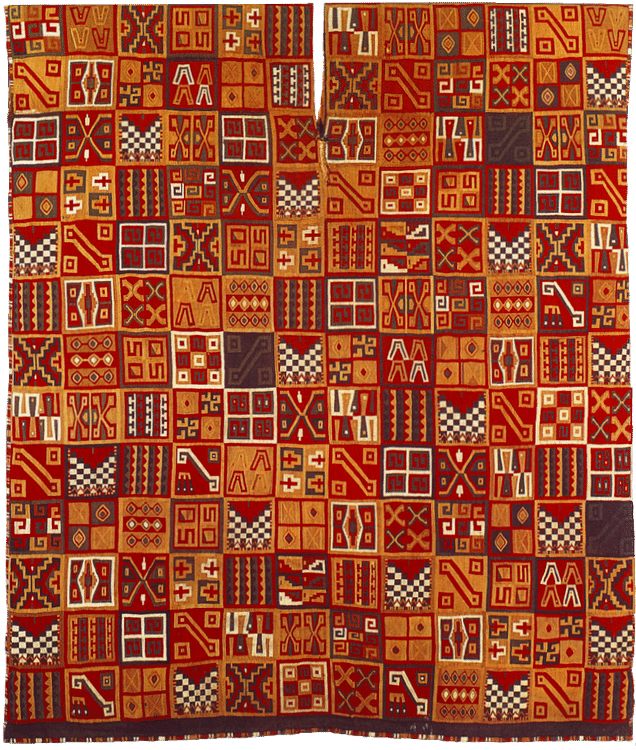
The art of the Inca civilization of Peru (c. 1425-1532 CE) produced some of the finest works ever crafted in the ancient Americas. Inca art is best seen in highly polished metalwork, ceramics, and, above all, textiles, with the last being considered the most prestigious by the Incas themselves. Designs often use geometrical shapes, are standardized, and technically accomplished. The European invaders destroyed much of Inca art either for sheer monetary gain or religious reasons but enough examples survive as testimony to the magnificent range and skills of Inca artists.
INFLUENCES & DESIGNS
Although influenced by the art and techniques of the earlier Chimu civilization, the Incas did create their own distinctive style which was an instantly recognisable symbol of imperial dominance across their massive empire. The Incas would go on to produce textiles, ceramics, and metal sculpture technically superior to any previous Andean culture, and this despite stiff competition from such masters of metalwork as the craftsmen of the Moche civilization.
Just as the Incas imposed a political dominance over their conquered subjects, so too with art, they imposed standard Inca forms and designs. The art itself did not suffer as a consequence, though. As art historian Rebecca Stone puts it,
Standardisation, though powerfully unifying, did not necessarily lower the quality of art; technically Inca tapestry, large-scale ceramic vessels, mortar-less masonry, and miniature metal sculptures are unsurpassed. ( Art of the Andes, 194)
The checkerboard stands out as a very popular design. One of the reasons for the repetition of designs was that pottery and textiles were often produced for the state as a tax, and so artworks were representative of specific communities and their cultural heritage. Just as today coins and stamps reflect a nation's history, so too, Andean artwork offered recognisable motifs which either represented the specific communities making them or the imposed designs of the ruling Inca class ordering them.The Incas did, though, allow local traditions to maintain their preferred colours and proportions. In addition, gifted artists such as those from Chan Chan or the Titicaca area and women particularly skilled at weaving were brought to Cuzco so that they could produce beautiful things for the Inca rulers.
ANDEAN ARTWORK OFFERED RECOGNISABLE MOTIFS WHICH REPRESENTED THE SPECIFIC COMMUNITIES MAKING THEM & THE IMPOSED DESIGNS OF THE RULING INCA CLASS ORDERING THEM.
It is also notable that both Inca pottery decoration and textiles did not include representations of themselves, their rituals, their military conquests, or such common Andean images as monsters and half-human, half-animal figures. Rather, the Incas almost always preferred colourful geometrical designs and abstract motifs representing animals and birds.
CERAMICS
Inca pottery used natural clay but added such materials as mica, sand, pulverised rock, and shell which prevented cracking during the firing process. There was no potter's wheel in the ancient Americas and so vessels were made by hand, first creating a base and then laying a coil of clay around it until the vessel reached the size required. Then the sides were smoothed using a flat stone. Smaller and medium-sized vessels were made using clay moulds. Before firing, a clay 'slip' was added and the vessel was painted, incised (sometimes using stamps), or had reliefs added. In kilns, pits, or open fires, the vessel was then fired using the oxidising method (adding oxygen to the flames) to create red, yellow and cream coloured pottery, or, via the reduction method (limiting the oxygen supply) to produce black wares.
Ceramics were for wider use, and so forms were, above all, practical. The most common shape was the urpu, a bulbous vessel used for storing maize with a long neck, flared lip, two small handles low on the pot, and a pointed base. The point at the base pressed into the ground and stabilised the pot while maize was poured into it. There were standardized sizes of urpubased on their content volume. They were decorated with abstract plant motifs and geometrical designs, most commonly zig-zags and dots. Examples from Cuzco are more elegant than those from other regions and are painted a distinctive black on red.

Inca Bird-handled Dish
Other types of ceramics are large flat serving dishes with animal figure handles, bowls, tall qeros beakers (made in pairs and also in wood), and the paccha. The latter was a hollow tube in the shape of a foot plough, typically decorated with three-dimensional additions such as a corn cob and urpu. The paccha (meaning 'waterfall') was placed into the ground so that maize beer could be ritually poured into it in ceremonies to promote a good harvest.
METALWORK
Objects using precious metals such as discs, jewellery, figurines, ceremonial knives ( tumi ), lime dippers, and everyday objects were made exclusively for Inca nobles. Gold was considered the sweat of the sun, and silver was considered the tears of the moon. Copper was another popular material, and these metals would have been inlaid with precious stones such as emeralds, polished semi-precious stones like lapis lazuli, polished bone, and spondylus shell. Alternatively, gold and silver were inlaid into bronze. Metals were alloyed, cast, beaten, incised, embossed, beaded, and used as gilding. Inca jewellery pieces made from precious metals included earrings, earspools, pendants, bracelets, and dress pins.
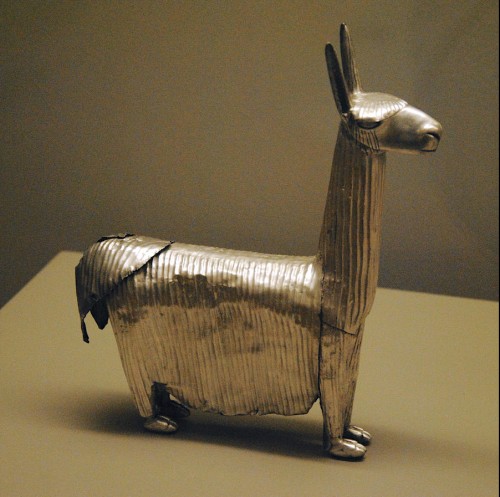
Inca Silver Alpaca
The Inca royalty only drank from gold and silver beakers, and their shoes had silver soles. Surviving figurines, both of humans and llamas, found in burial sites were made either by cast or with up to 18 separate sheets of gold and carved in intricate life-like detail. Gold and silver were also used for many religious pieces, especially representations of natural phenomena and places the Incas held sacred. These works represented the sun, moon, stars, rainbows, lightning, waterfalls, and so on. Masks representing the principal gods such as Inti the god of the sun and Mama Kilya the goddess of the moon, along with other sacred objects, were then placed within Inca temples but these have since been lost.
Perhaps the most famously lost Inca art piece is a gold statue of Inti, represented as a small seated boy and known as Punchao, which was kept in the Temple of the Sun, at the Coricancha ( Qorikancha ) sacred complex at Cuzco. With rays projecting from his head and decorated with gold jewellery, the stomach of this figure was used as a receptacle for the ashes of the burned vital organs of previous Inca kings. Each day the statue was brought outside of the temple to bask in the sun.Following the Spanish conquest the figure was removed and hidden, never to be found again.
The Coricancha also had a stunning garden dedicated to Inti. Everything in it was made of gold and silver. A large field of corn and life-size models of shepherds, llamas, jaguars, guinea pigs, monkeys, birds and even butterflies and insects were all crafted in precious metal. All that survives of these wonders are a few golden corn stalks, a convincing, if silent, testimony to the lost treasures of Inca metalworkers.
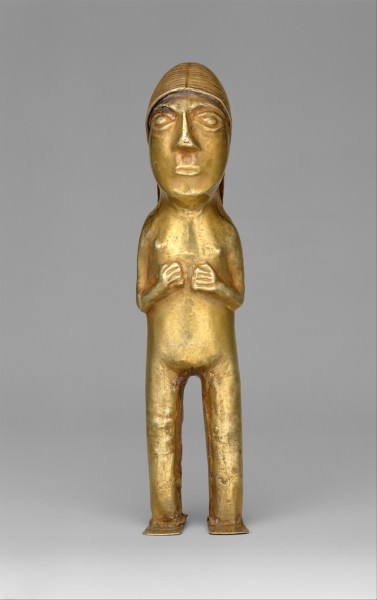
Inca Gold Female Figurine
TEXTILES
Although very few examples of Inca textiles survive from the heartland of the empire, we do have, thanks to the dryness of the Andean environment, many textile examples from the highlands and mountain burial sites. In addition, Spanish chroniclers often made drawings of textile designs and clothing so that we have a reasonable picture of the varieties in use. Consequently, we have many more examples of textiles than other crafts such as ceramics and metalwork.
For the Incas, finely worked and highly decorative textiles came to symbolize both wealth and status. Fine cloth could be used as both a tax and currency, and the very best textiles became amongst the most prized of all possessions, even more precious than gold or silver. Inca weavers were technically the most accomplished the Americas had ever seen and, with up to 120 wefts per centimetre, the best fabrics were considered the most precious gifts of all. As a result, when the Spanish arrived in the early 16th century CE, it was textiles and not metal goods which were given in welcome to these visitors from another world.
It seems that both men and women created textiles, but it was a skill women of all classes were expected to be accomplished at. At the capital Cuzco, the finest cloth was made by male specialists known as qumpicamayocs or 'keepers of the fine cloth'.The principal equipment was the backstrap loom for smaller pieces and either the horizontal single-heddle loom or vertical loom with four poles for larger pieces. Spinning was done with a drop spindle, typically in ceramic or wood. Inca textiles were made using cotton (especially on the coast and in the eastern lowlands) or llama, alpaca, and vicuña wool (more common in the highlands) which can be exceptionally fine. Goods made using the super-soft vicuña wool were restricted and only the Inca ruler could own vicuña herds. Rougher textiles were also made using maguey fibres.
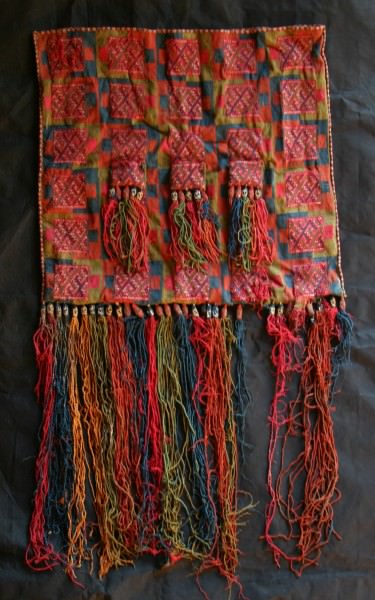
Inca Textile Bag
The principal colours used in Inca textiles were black, white, green, yellow, orange, purple, and red. These colours came from natural dyes which were extracted from plants, minerals, insects, and molluscs. Colours also had specific associations. For example, red was equated with conquest, rulership, and blood. This was most clearly seen in the Mascaypacha, the Inca state insignia, where each thread of its red tassel symbolised a conquered people. Green represented rainforests, the peoples who inhabited them, ancestors, rain and its consequent agricultural growth, coca, and tobacco. Black signified creation and death, while yellow could signal maize or gold. Purple was, as in the rainbow, considered the first colour and associated with Mama Oclla, the founding mother of the Inca race.
Besides using dyed strands to weave patterns, other techniques included embroidery, tapestry, mixing different layers of cloth, and painting – either by hand or using wooden stamps. The Incas favoured abstract geometric designs, especially checkerboard motifs, which repeated patterns ( tocapus ) across the surface of the cloth. Certain patterns may also have been ideograms. Non-geometrical subjects, often rendered in abstract form, included felines (especially jaguars and pumas), llamas, snakes, birds, sea creatures, and plants. Clothes were simply patterned, commonly with square designs at the waist and fringes and a triangle marking the neck. One such design was the standard military tunic which consisted of a black and white checkerboard design with an inverted red triangle at the neck.
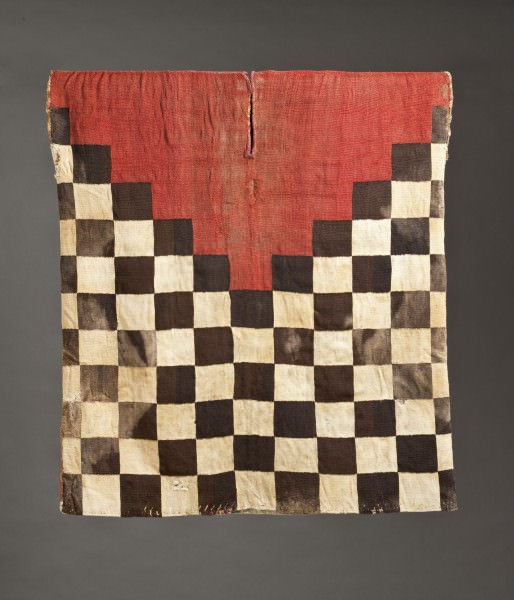
Inca Military Tunic
Additional decoration could be added to textile articles in the form of tassels, brocade, feathers, and beads of precious metal or shell. Precious metal threads could also be woven into the cloth itself. As feathers were usually from rare tropical birds and condors, these garments were reserved for the royal family and nobility.
CONCLUSION
The European invaders in the 16th century CE not only ruthlessly melted down or spirited away any precious Inca goods they found but also attempted to repress elements of Inca art, even banning such trivial objects as the qeros beakers in an attempt to curb drinking habits. Distinctive Inca textile designs such as those connected to royal power were also discouraged but, in defiance, many of the indigenous peoples continued with their artistic traditions. Thanks to this perseverance and continuity, and despite an evolution where designs were blended with elements of colonial art, many traditional Inca designs and motifs survive to this day and are celebrated as such in the ceramics, metalwork, and textiles of modern Peru.
LICENSE:
Article based on information obtained from these sources:with permission from the Website Ancient History Encyclopedia
Content is available under License Creative Commons: Attribution-NonCommercial-ShareAlike 3.0 Unported. CC-BY-NC-SA License